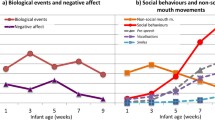Summary
Social and emotional development begins from the moment of birth. Remarkably, infants are able to engage with their social world, particularly their parents and family. They start to establish a secure attachment with their primary caregivers who provide not only nurturance but guidance. A sense of security facilitates infants' exploration of their physical and social world. They demonstrate selective preferences—they prefer to look at faces and listen to voices—that reflect their genetically programmed disposition. Infants are able to express their emotions and recognize the emotional expressions of others. The development of basic human attributes emerge in the first few weeks and months of life. Caring, loving adults play such a critical role in providing learning opportunities to interact with others and express their emotions in an appropriate manner. Adults shape the quality of experiences that infants encounter and provide the basic building blocks of trust that support further development later in life.
Similar content being viewed by others
References
Ainsworth, M. D. S. (1993). Attachment as related to mother-infant interaction. In C. Rovee-Collier & L. P. Lipsitt (Eds.),Advances in infancy research (Vol. 8, pp. 1–50). Norwood, NJ: Ablex.
Ainsworth, M. D. S., Blehar, M. C., Waters, E., & Wall, S. (1978).Patterns of attachment: A psychological study of the strange situation. Hillsdale, NJ: Erlbaum.
Haviland, J. M., & Lelwica, M. (1987). The induced affect response: 10-week-old infants' responses to three emotion expressions.Developmental Psychology, 23, 97–104.
Izard, C. E. (1991).The psychology of emotions. New York: Plenum.
Izard, C. E., Hembree, E. A., & Huebner, R. R. (1987). Infants' emotion expressions to acute pain: Developmental change and stability of individual differences.Developmental Psychology, 23, 105–113.
Kaye, K., & Wells, A. J. (1980). Mother's jiggling and the burst-pause pattern in neonatal feeding.Infant Behavior and Development, 3, 29–46.
Takahashi, K. (1990). Are the key assumptions of the “Strange Situation” procedure universal? A view from Japanese research.Human Development, 33, 23–30.
Termine, N. T., & Izard, C. E. (1988). Infants' responses to their mothers' expressions of joy and sadness.Developmental Psychology, 24, 223–229.
van Ijzendoorn, M. H., & Kroonenberg, P. M. (1988). Cross-cultural patterns of attachment: A meta-analysis of the Strange Situation.Child Development, 59, 147–156.
Youngblade, L. M., & Belsky, J. (1992). Parent-child antecedents of 5-year-olds' close friendships: A longitudinal analysis.Developmental Psychology, 28, 700–713.
Rights and permissions
About this article
Cite this article
Caulfield, R. Social and emotional development in the first two years. Early Childhood Educ J 24, 55–58 (1996). https://doi.org/10.1007/BF02430553
Issue Date:
DOI: https://doi.org/10.1007/BF02430553




